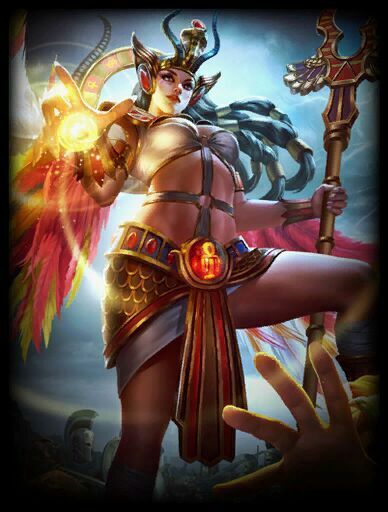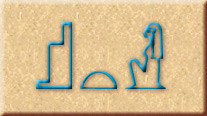I am not a fan of comicbooky-videogamey over-sexualized depictions of the Deities. I am especially not a fan of images of Goddesses with huge, spherical boobs that would hurt like heck in real combat (oh, it’s always about combat; you know that.) Personally, I like my Deity images to be either historical or, if they are art, to capture something of the awe of the Divine. But that’s just me.
Nevertheless, I was amused, or perhaps bemused, when the popular video game Smite introduced a new fightin’ Deity back in 2013: Isis, Goddess of Magic. They even have a halfway decent version of Her myth in the game’s character information.
Then, earlier this week, the company that makes Smite announced that they will rename the character Isis as Eset, to be pronounced “Ee-set.” The idea is to be able to avoid being caught in YouTube’s “ISIS is a terrorist group” algorithms. Sigh. I wish we had been able to get people to call them ISIL or Daesh (or, really, anything else), but “ISIS” is just too easy, just too familiar, for people.
Which is precisely why I continue to use it in my blog and books; it’s the familiar name by which She is known to more people throughout the world. Yes, I can be stubborn. Of course, as many of you know, “Eye-sis” is the Anglicized version of what the ancient Greeks called Her: Ἶσις (EES-Ees).
I represent Her Egyptian name as Iset. Here’s why:
In Egyptian, Isis’ name was most often spelled with the hieroglyphs throne, semi-circle (possibly a bread loaf), Goddess, although during the thousands of years of Her worship there were a number of variant spellings. Egyptian artists commonly designated Isis by painting the throne hieroglyph on Her crown. Thus it is possible to identify the shortest version of Isis’ name with the throne itself. The Goddess Isis is the Goddess Throne.
Similar to Hebrew, the Egyptian hieroglyphs don’t represent the vowels. They had vowels, of course. You were just expected to know where to put them to pronounce the words, plus some of the glyphs function as semi-vowels. As a result, we don’t know precisely how the ancient Egyptians would have pronounced Isis’ name. (Not only that; the pronunciation of words changes over time and Egyptians had regional accents.)
The throne hieroglyph is a biliteral symbol (*it could sometimes even be a triliteral), that is, a single symbol representing several sounds. The semi-circle is a single-sound glyph and represents our letter t. In this case, it provides the feminine ending of the word just as in English we might add -ess to feminize a word. The Goddess symbol is a determinative and provides the overall concept of the word, but has no sound. (And just to complicate things, the throne glyph itself can be used as a determinative.)
The first of the two sounds comprising the biliteral throne symbol is a consonant similar to the Hebrew yod** and is represented by modern Egyptologists as ı͗ . The yod sound is similar to English y or i, but remember that it’s not really a vowel. In hieroglyphs, the yod is represented by the reed flower glyph. The initial sound may also be referred to as another Hebrew letter, aleph, the vulture glyph. It’s a glottal stop, but for convenience is sometimes given as an a. The second of the two sounds in the throne is an s. Between the yod or aleph and the s, any vowel could have been inserted. Similarly, a vowel could be inserted between the throne and the semi-circle.
So how can we know which vowels were used? We do have some clues, at least from a later period, in ancient Coptic and Greek.

Coptic is a late form of Egyptian (today, very late as it still survives in the Coptic church) that uses Greek letters plus some special letters to represent Egyptian sounds. By the time Egyptian had changed into Coptic, Isis is Ese (Aay-seh or Ee-seh) or Esi (Aay-see or Ee-see) (the final t was dropped in Coptic, and likely in pronunciation earlier).*** From their earliest encounter with Egyptian religion, the Greeks—and Egyptians who wrote Greek—spelled Her name asἾσις, which they would have pronounced as EES-ees. In Late Antiquity, they sometimes added an epsilon at the beginning so that an alternative pronunciation would have been Aay-sis. So from examples of Her name in Coptic and Greek—contemporary pronunciations that were actually being used by the people who recorded them—we can narrow the search for initial vowels down to either an ee sound or an ay sound. In earlier times, then, the first syllable of the Goddess’ name was probably Ees and in the late period may have changed to Aays. (How could that happen? In the same way that modern English no longer sounds like Chaucer’s English. Ancient Egyptian was spoken for thousands of years and naturally changed during that long time period.)
Between the throne and the semi-circle, Egyptologists usually insert a generic e before the final t to create the feminine ending in line with the Egyptological convention of representing the feminine ending as et as in Amunet, the feminine form of Amun. (It is entirely possible that this e could have been another vowel, for example, i.) Nonetheless, by combining the information we have about Her name as pronounced in Coptic and Greek with current scholarly opinion, it is most likely that Isis in Egyptian would have been pronounced Ee-seh (or Ee-set with the t) and in Late Antiquity also as Aay-seh (or Aay-set with the t). Either of these could have been Hellenized to Isis by replacing the ending with the Greek –is ending. I prefer Iset (Ee-set) to Eset (Ee-set) because it looks closer to Her most well-known name, but Eset works as does Aset (Aay-set).

Of course, all this is just for the sticklers among us. Isis will know those who call upon Her no matter what pronunciation we use. She’s a Goddess. She knows. Yet, the various pronunciations of Her name are of interest because of the emphasis that the Egyptians themselves placed on knowing the true name of a Deity, person, or thing in order to know its essential nature.
We can use the various pronunciations of the Goddess’ name to touch different aspects of Her nature. For example, to contact a very Egyptian form of the Goddess, we might invoke Her by the name Iset or Ise. For a more Hellenized aspect, we might call upon Isis using the Greek pronunciation, Ees-ees. Many people will call upon Her using the Anglicized version of Her name, Eye-sis. In any and all of these names, we will still be contacting the energy of the Goddess Isis, She of the 10,000 Names. The difference will be not in the essence of the Goddess, but in the particular “flavor” of Her energy that we touch. Personally, right now I’m using Coptic Ese (Aay-seh) a lot lately. It chants beautifully.
In the Book of Coming Forth by Day, better known as the Book of the Dead, Isis is called Iset Nudjerit em Renus Nebu, “Isis, Goddess in All Names.” Perhaps, we can see Her not only as the Goddess of All Names, but of All Pronunciations as well.
*In some uses, the multi-literal throne hieroglyph includes the t consonant; in that case the loaf t indicates the feminine ending.

**A century ago, in his hugely influential books (which are still so because Dover keeps them readily available), Sir E.A. Wallis Budge used a peculiar set of symbols to transliterate the hieroglyphs, and one of them in particular continues to confuse readers to this day. Instead of the ı͗ used by other Egyptologists and often called yod, Budge represents the reed flower as å (that’s not quite it; the dot should be solid, but it was all I could get WordPress to do.) Most people look at it and read it as “a” rather than a “yod.“
***There are several forms of Coptic with different spellings and pronunciations of Her name.







